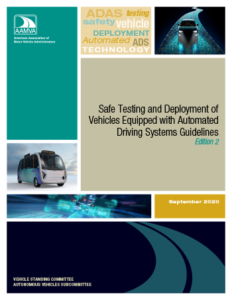Smooth Operators
AAMVA’s Automated Vehicle Subcommittee updates guidance
More and more vehicles with ever higher levels of automation are being tested, preparing for road-readiness in the coming years. AAMVA’s Automated Vehicle Subcommittee has updated its guidance to address how jurisdictions can best manage testing and deployment of these vehicles, and how people will use and interact with them.
 The subcommittee is a group of 20 individuals from jurisdictions around the U.S. and Canada who have expertise in vehicle-related programs, as well as driver programs and law enforcement agencies. They have been learning constantly about the vehicles and their technology as new information becomes available from manufacturers and other groups, and they have been working to provide additional information to jurisdictions. This second edition of the report, launched in September, replaces the first edition document released in 2018.
The subcommittee is a group of 20 individuals from jurisdictions around the U.S. and Canada who have expertise in vehicle-related programs, as well as driver programs and law enforcement agencies. They have been learning constantly about the vehicles and their technology as new information becomes available from manufacturers and other groups, and they have been working to provide additional information to jurisdictions. This second edition of the report, launched in September, replaces the first edition document released in 2018.
One of the first issues addressed was terminology. This report retires the use of the terms “autonomous vehicle” and “highly automated vehicle” in favor of “automated driving systems (ADS)” or “ADS-equipped vehicles.” New terms will also cover vehicles with advanced driver-assistance systems (ADAS).
The document consolidates guidance for jurisdictions and lessens the burden of having to develop procedures and rules on the fly. The subcommittee operates with the knowledge that there is so much information about these vehicles, that it is almost impossible for any single jurisdiction to read everything and stay up to date. By combining all of the information from the perspective of law enforcement and motor vehicle agencies, the second edition has covered a lot of ground on behalf of those stakeholders.
Like the previous document, edition 2 outlines considerations on testing vehicles, safety standards, and driver training and testing. This version updates many of those sections and provides new guidance regarding law enforcement and first responder interactions, cybersecurity, data collection, as well as testing and deployment of low-speed automated shuttles, connected vehicles and platoons operated in sync with vehicle-to-vehicle (V-to-V) communication.
The section devoted to law enforcement officers gives an overview of the technology and guidance on how to interact with it and prepare for it. This will help law enforcement prepare for future scenarios where they encounter a vehicle that doesn’t have a human driver in it, whether that is during day-to-day traffic encounters or in the course of suspected criminal activity.
As we all have learned in our tech-dependent society, cybersecurity cannot be an afterthought. Computer systems in these vehicles manage how the vehicle operates, where it goes and how it interprets what it is encountering—and any one of those systems could be compromised. The subcommittee has included recommendations for automakers, NHTSA, the National Institute of Standards and Technology, and the Auto Information Sharing and Analysis Center on hardening computer systems to prevent cyberattacks.
The subcommittee recommends that jurisdictions make the report available to the appropriate staff in their agencies. Because the group has taken a deep dive on so many topics, jurisdictions should have as many people as possible review the document to understand how this technology will specifically impact their areas of expertise.




